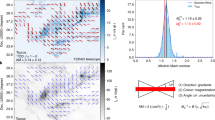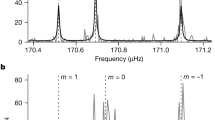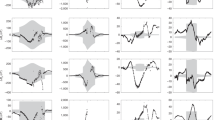Abstract
A large number of high-accuracy vector measurements of the Earth's magnetic field have recently become available from the satellite Oersted, complementing previous vector data from the satellite Magsat, which operated in 1979/80. These data can be used to infer the morphology of the magnetic field at the surface of the fluid core1, ∼2,900 km below the Earth's surface. Here I apply a new methodology to these data to calculate maps of the magnetic field at the core surface which show intense flux spots in equatorial regions. The intensity of these features is unusually large—some have intensities comparable to high-latitude flux patches near the poles, previously identified as the major component of the dynamo field2. The tendency for pairing of some of these spots to the north and south of the geographical equator suggests they might be associated with the tops of equatorially symmetric columnar structures in the fluid, or their antisymmetric equivalents. The drift of the equatorial features may represent material flow or could represent wave motion; discrimination of these two effects based on future data could provide new information on the strength of the hidden toroidal magnetic field of the Earth.
This is a preview of subscription content, access via your institution
Access options
Subscribe to this journal
Receive 51 print issues and online access
$199.00 per year
only $3.90 per issue
Buy this article
- Purchase on Springer Link
- Instant access to full article PDF
Prices may be subject to local taxes which are calculated during checkout



Similar content being viewed by others
References
Backus, G. E., Parker, R. & Constable, C. Foundations of Geomagnetism (Cambridge Univ. Press, Cambridge, 1996)
Bloxham, J. & Gubbins, D. The secular variation of Earth's magnetic field. Nature 317, 777–781 (1985)
Jackson, A., Jonkers, A. R. T. & Walker, M. Four centuries of geomagnetic secular variation from historical records. Phil. Trans. R. Soc. Lond. A 358(1768), 957–990 (2000)
Backus, G. E. & Gilbert, F. Numerical applications of a formalism for geophysical inverse problems. Geophys. J. R. Astron. Soc. 13, 247–276 (1967)
Parker, R. L. Geophysical Inverse Theory (Princeton Univ. Press, Princeton, 1994)
Tikhonov, A. N. & Arsenin, V. Y. Solutions of Ill-posed Problems (John Wiley and Sons, London, 1977)
Roberts, P. H. & Glatzmaier, G. A. A test of the frozen-flux approximation using a new geodynamo model. Phil. Trans. R. Soc. Lond. 358, 1109–1121 (2000)
Bondi, H. & Gold, T. On the generation of magnetism by fluid motion. Mon. Not. R. Astron. Soc. 110, 607–611 (1950)
Gull, S. F. & Daniell, G. J. Image reconstruction from incomplete and noisy data. Nature 272, 686–690 (1978)
Gull, S. F. & Skilling, J. Maximum entropy method in image processing. IEEE Proc. 131(F), 646–659 (1984)
Buck, B. & Macaulay, V. A. (eds) Maximum Entropy in Action (Oxford Univ. Press, Oxford, 1991)
Christensen, U., Olsen, P. & Glatzmaier, G. A. Numerical modelling of the geodynamo: a systematic parameter study. Geophys. J. Int. 138, 393–409 (1999)
Constable, C. G., Parker, R. L. & Stark, P. B. Geomagnetic field models incorporating frozen-flux constraints. Geophys. J. Int. 113, 419–433 (1993)
Baumgardner, J. & Fredrickson, P. O. Icosahedral discretization of the two-sphere. SIAM J. Num. Anal. 22, 1107–1115 (1985)
Gull, S. F. & Skilling, J. The MEMSYS5 User's Manual (Maximum Entropy Data Consultants Ltd, Royston, 1990); available at 〈http://www.maxent.co.uk/documents/MemSys5_manual.pdf〉
Hulot, G., Eymin, C., Langlais, B., Mandea, M. & Olsen, N. Small-scale structure of the geodynamo inferred from Oersted and Magsat data. Nature 416, 620–623 (2002)
Gubbins, D. & Kelly, P. Persistent patterns in the geomagnetic field during the last 2.5 Myr. Nature 365, 829–832 (1993)
Zhang, K. On equatorially trapped boundary inertial waves. J. Fluid Mech. 248, 203–217 (1993)
Malkus, W. V. R. Hydromagnetic planetary waves. J. Fluid. Mech. 28, 793–802 (1967)
Hide, R. Free hydrodynamic oscillations of the Earth's core and the theory of the geomagnetic secular variation. Phil. Trans. R. Soc. Lond. 259, 615–647 (1966)
Holme, R. & Bloxham, J. The treatment of attitude errors in satellite geomagnetic data. Phys. Earth Planet. Int. 98, 221–233 (1996)
Olsen, N. & members of the Ørsted International Science Team. Ørsted Initial Field Model. Geophys. Res. Lett. 27, 3607–3610 (2000)
Acknowledgements
The provision of high-quality Oersted data is due to the efforts of the Oersted Project team, for which I am grateful. I thank C. Constable and R. Parker for their hospitality, discussions and sharing of software, and C. Finlay for comments.
Author information
Authors and Affiliations
Corresponding author
Ethics declarations
Competing interests
The author declares that he has no competing financial interests.
Rights and permissions
About this article
Cite this article
Jackson, A. Intense equatorial flux spots on the surface of the Earth's core. Nature 424, 760–763 (2003). https://doi.org/10.1038/nature01879
Received:
Accepted:
Issue Date:
DOI: https://doi.org/10.1038/nature01879
This article is cited by
-
Core Eigenmodes and their Impact on the Earth’s Rotation
Surveys in Geophysics (2022)
-
A generating process of geomagnetic drifting field
Earth, Planets and Space (2018)
-
Geomagnetic spikes on the core-mantle boundary
Nature Communications (2017)
-
Investigation of the SA evolution by using the CHAOS-4 model over 1997–2013
Science China Earth Sciences (2016)
-
Towards more realistic core-mantle boundary heat flux patterns: a source of diversity in planetary dynamos
Progress in Earth and Planetary Science (2015)
Comments
By submitting a comment you agree to abide by our Terms and Community Guidelines. If you find something abusive or that does not comply with our terms or guidelines please flag it as inappropriate.



